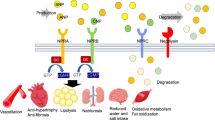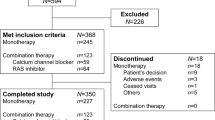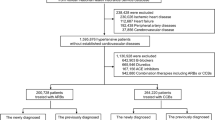Abstract
Hypertension is a significant risk factor for cardiovascular disease (CVD), including stroke, myocardial infarction, kidney disease and heart failure. Considerable research has been undertaken to delineate the differential effects of various classes of antihypertensive agents in delaying or preventing cardiovascular morbidity and mortality. Although possible benefits may result from specific agents or classes of agents in certain high-risk subgroups, prompt and intensive blood pressure (BP) reduction to target levels remains the most crucial factor in this benefit. Despite this, the BP remains above the target level in a large majority of patients, reinforcing the need for improved treatment paradigms. Among antihypertensive agents, inhibitors of the renin–angiotensin system—angiotensin-II receptor blockers and angiotensin-converting enzyme inhibitors—and long-acting dihydropyridine calcium channel blockers (DHP-CCBs) have been shown to provide safe, effective and well-tolerated BP control. These agents have also been proven as effective as, and in some cases superior to, other classes of agents in reducing cardiovascular morbidity and mortality. As the majority of high-risk patients require at least two and possibly even three medications to achieve the target BP, combination therapy with these two classes of drugs is a rational approach to therapy. Whether fixed-dose combination therapy with a renin–angiotensin system inhibitor plus a DHP-CCB affords greater clinical benefit compared with other combination regimens remains to be determined in large, prospective clinical trials. Meanwhile, such a combination offers effective, convenient, well-tolerated control of the most important modifiable risk factor for CVD.
This is a preview of subscription content, access via your institution
Access options
Subscribe to this journal
Receive 12 digital issues and online access to articles
$119.00 per year
only $9.92 per issue
Buy this article
- Purchase on Springer Link
- Instant access to full article PDF
Prices may be subject to local taxes which are calculated during checkout



Similar content being viewed by others
References
Chobanian AV, Bakris GL, Black HR, Cushman WC, Green LA, Izzo Jr JL et al. The Seventh Report of the Joint National Committee on prevention, detection, evaluation, and treatment of high blood pressure. Hypertension 2003; 42: 1206–1252.
Ong KL, Cheung BM, Man YB, Lau CP, Lam KS . Prevalence, awareness, treatment, and control of hypertension among United States adults 1999–2004. Hypertension 2007; 49: 69–75.
Fields LE, Burt VL, Cutler JA, Hughes J, Roccella EJ, Sorlie P . The burden of adult hypertension in the United States 1999 to 2000: a rising tide. Hypertension 2004; 44: 398–404.
Wolf-Maier K, Cooper RS, Kramer H, Banegas JR, Giampaoli S, Joffre S et al. Hypertension treatment and control in five European countries, Canada, and the United States. Hypertension 2004; 43: 10–17.
MacMahon S, Alderman MH, Lindholm LH, Liu L, Sanchez RA, Seedat YK . Blood-pressure-related disease is a global health priority. Lancet 2008; 371: 1480–1482.
Lawes CMM, Vander Hoorn S, Rodgers A, for the International Society of Hypertension. Global burden of blood-pressure-related disease, 2001. Lancet 2008; 371: 1513–1518.
Cheung BMY, Ong KL, Man YB, Lam KSL, Lau C-P . Prevalence, awareness, treatment, and control of hypertension: United States National Health and Nutrition Examination Survey 2001–2002. J Clin Hypertens 2006; 8: 93–98.
Gu Q, Paulose-Ram R, Dillon C, Burt V . Antihypertensive medication use among US adults with hypertension. Circulation 2006; 113: 213–221.
Ezzati M, Lopez AD, Rodgers A, Vander Hoorn S, Murray CJ . Selected major risk factors and global and regional burden of disease. Lancet 2002; 360: 1347–1360.
Blood Pressure Lowering Treatment Trialists’ Collaboration. Effects of different blood-pressure-lowering regimens on major cardiovascular events: results of prospectively designed overviews of randomised trials. Lancet 2003; 362: 1527–1535.
Staessen JA, Li Y, Thijs L, Wang JG . Blood pressure reduction and cardiovascular prevention: an update including the 2003–2004 secondary prevention trials. Hypertens Res 2005; 28: 385–407.
Hansson L, Zanchetti A, Carruthers SG, Dahlöf B, Elmfeldt D, Julius S et al. Effects of intensive blood-pressure lowering and low-dose aspirin in patients with hypertension: principal results of the Hypertension Optimal Treatment (HOT) randomised trial. Lancet 1998; 351: 1755–1762.
UK Prospective Diabetes Study Group. Tight blood pressure control and risk of macrovascular and microvascular complications in type 2 diabetes: UKPDS 38. BMJ 1998; 317: 703–713.
The Task Force for the Management of Arterial Hypertension of the European Society of Hypertension (ESH) and of the European Society of Cardiology (ESC). 2007. Guidelines for the management of arterial hypertension. J Hypertens 2007; 25: 1105–1187.
Basile J . The role of existing and newer calcium channel blockers in the treatment of hypertension. J Clin Hypertens 2004; 6: 621–631.
Burnier M . Angiotensin II type 1 receptor blockers. Circulation 2001; 103: 904–912.
Burnier M, Brunner HR . Angiotensin II receptor antagonists. Lancet 2000; 355: 637–645.
Dahlöf B, Devereux RB, Kjeldsen SE, Julius S, Beevers G, de Faire U et al. Cardiovascular Morbidity and Mortality in the Losartan Intervention for Endpoint Reduction in Hypertension Study (LIFE): a randomised trial against atenolol. Lancet 2002; 359: 995–1003.
Dahlöf B, Sever PS, Poulter NR, Wedel H, Beevers DG, Caulfield M et al. Prevention of cardiovascular events with an antihypertensive regimen of amlodipine adding perindopril as required versus atenolol adding bendroflumethiazide as required, in the Anglo-Scandinavian Cardiac Outcomes Trial-Blood Pressure Lowering Arm (ASCOT-BPLA): a multicentre randomized controlled trial. Lancet 2005; 366: 895–906.
Liebson PR . Calcium channel blockers in the spectrum of antihypertensive agents. Expert Opin Pharmacother 2006; 7: 2385–2401.
Schmieder RE, Hilgers KF, Schlaich MP, Schmidt BM . Renin–angiotensin system and cardiovascular risk. Lancet 2007; 369: 1208–1219.
Asmar R . Targeting effective blood pressure control with angiotensin receptor blockers. Int J Clin Pract 2006; 60: 315–320.
Cohn JN, Tognoni G, for the Valsartan Heart Failure Trial Investigators. A randomized trial of the angiotensin-receptor blocker valsartan in chronic heart failure. N Engl J Med 2001; 345: 1667–1675.
The ALLHAT Officers and Coordinators for the ALLHAT Collaborative Research Group. Major outcomes in high-risk hypertensive patients randomized to angiotensin-converting enzyme inhibitor or calcium channel blocker vs diuretic: the Antihypertensive and Lipid-Lowering Treatment to Prevent Heart Attack Trial (ALLHAT). JAMA 2002; 288: 2981–2997.
Hansson L, Lindholm LH, Ekbom T, Dahlöf B, Lanke J, Scherstén B et al. Randomised trial of old and new antihypertensive drugs in elderly patients: cardiovascular mortality and morbidity: the Swedish Trial in Old Patients with Hypertension-2 Study. Lancet 1999; 354: 1751–1756.
Hansson L, Lindholm LH, Niskanen L, Lanke J, Hedner T, Niklason A et al. Effect of angiotensin-converting-enzyme inhibition compared with conventional therapy on cardiovascular morbidity and mortality in hypertension: the Captopril Prevention Project (CAPPP) randomised trial. Lancet 1999; 353: 611–616.
Heart Outcomes Prevention Evaluation Study Investigators. Effect of an angiotensin-converting-enzyme inhibitor, ramipril, on cardiovascular events in high-risk patients. N Engl J Med 2000; 342: 145–153.
PROGRESS Collaborative Group. Randomised trial of perindopril-based blood-pressure-lowering regimen among 6105 individuals with previous stoke or transient ischaemic attack. Lancet 2001; 358: 1033–1041.
Wing LMH, Reid CM, Ryan P, Beilin LJ, Brown MA, Jennings GL et al. A comparison of outcomes with angiotensin-converting-enzyme inhibitors and diuretics for hypertension in the elderly. N Engl J Med 2003; 348: 583–592.
Niskanen L, Hedner T, Hansson L, Lanke J, Niklason A, CAPPP Study Group. Reduced cardiovascular morbidity and mortality in hypertensive diabetic patients on first-line therapy with an ACE inhibitor compared with a diuretic/β-blocker-based treatment regimen. Diabetes Care 2001; 24: 2091–2096.
Maggioni AP, Anand I, Gottlieb SO, Latini R, Tognoni G, Cohn JN, on behalf of the Val-HeFT Investigators. Effects of valsartan on morbidity and mortality in patients with heart failure not receiving angiotensin-converting enzyme inhibitors. J Am Coll Cardiol 2002; 40: 1414–1421.
Wachtell K, Lehto M, Gerdts E, Olsen MH, Hornestam B, Dahlöf B et al. Angiotensin II receptor blockade reduces new-onset atrial fibrillation and subsequent stroke compared to atenolol: the Losartan Intervention For End Point Reduction in Hypertension (LIFE) Study. J Am Coll Cardiol 2005; 45: 712–719.
Lindholm LH, Ibsen H, Dahlöf B, Devereux RM, Beevers G, de Faire U et al. Cardiovascular morbidity and mortality in patients with diabetes in the Losartan Intervention For Endpoint Reduction in Hypertension Study (LIFE): a randomised trial against atenolol. Lancet 2002; 359: 1004–1010.
Julius S, Kjeldsen SE, Weber M, Brunner HR, Ekman S, Hansson L et al. Outcomes in hypertensive patients at high cardiovascular risk treated with regimens based on valsartan or amlodipine: the VALUE randomised trial. Lancet 2004; 363: 2022–2031.
Weber MA, Julius S, Kjeldsen SE, Brunner HR, Ekman S, Hansson L et al. Blood pressure dependent and independent effects of antihypertensive treatment on clinical events in the VALUE Trial. Lancet 2004; 363: 2049–2051.
Devereux RB, Dahlöf B . Potential mechanisms of stroke benefit favoring losartan in the Losartan Intervention for Endpoint Reduction in Hypertension (LIFE) Study. Curr Med Res Opin 2007; 23: 443–457.
Schmieder R, Kjeldsen SE, Julius S, McInnes GT, Zanchetti A, Hua T et al. Reduced incidence of new onset atrial fibrillation with angiotensin II receptor blockade: the VALUE-trial [abstract]. Eur Heart J 2006; 27: 446.
Mochizuki S, Dahlöf B, Shimizu M, Ikewaki K, Yoshikawa M, Taniguchi I et al. Valsartan in a Japanese population with hypertension and other cardiovascular disease (Jikei Heart Study): a randomised, open-label, blinded endpoint morbidity-mortality study. Lancet 2007; 369: 1431–1439.
Poulter NR, Wedel H, Dahlöf B, Sever PS, Beevers DG, Caulfield M et al. Role of blood pressure and other variables in the differential cardiovascular event rates noted in the Anglo-Scandinavian Cardiac Outcomes Trial-Blood Pressure Lowering Arm (ASCOT-BPLA). Lancet 2005; 366: 907–913.
The CAFE Investigators, for the Anglo-Scandinavian Cardiac Outcomes Trial (ASCOT) Investigators. Differential impact of blood pressure-lowering drugs on central aortic pressure and clinical outcomes: principal results of the Conduit Artery Function Evaluation (CAFE) Study. Circulation 2006; 113: 1213–1225.
Nissen SE, Tuzcu EM, Libby P, Thompson PD, Ghali M, Garza D et al. Effect of antihypertensive agents on cardiovascular events in patients with coronary disease and normal blood pressure: the CAMELOT Study: a randomized controlled trial. JAMA 2004; 292: 2217–2226.
Bakris GL, Weir MR, for the Study of Hypertension and the Efficacy of Lotrel in Diabetes (SHIELD) Investigators. Achieving goal blood pressure in patients with type 2 diabetes: conventional versus fixed-dose combination approaches. J Clin Hypertens (Greenwich) 2003; 5: 202–209.
Jamerson KA, Nwose O, Jean-Louis L, Schofield L, Purkayastha D, Baron M . Initial angiotensin-converting enzyme inhibitor/calcium channel blocker combination therapy achieves superior blood pressure control compared with calcium channel blocker monotherapy in patients with stage 2 hypertension. Am J Hypertens 2004; 17: 495–501.
Jamerson KA, Bakris GL, Wun CC, Dahlöf B, Lefkowitz M, Manfreda S et al. Rationale and design of the Avoiding Cardiovascular Events Through Combination Therapy in Patients Living with Systolic Hypertension (ACCOMPLISH) Trial: the first randomized controlled trial to compare the clinical outcome effects of first-line combination therapies in hypertension. Am J Hypertens 2004; 17: 793–801.
Weber MA, Bakris GL, Dahlöf B, Pitt B, Velazquez E, Gupte J et al. Baseline characteristics in the Avoiding Cardiovascular Events Through Combination Therapy in Patients Living with Systolic Hypertension (ACCOMPLISH) Trial: a hypertensive population at high cardiovascular risk. Blood Press 2007; 16: 13–19.
O’Riordan M . ACCOMPLISH: ACE inhibitor plus calcium-channel blocker best for reducing clinical events in hypertensive patients. Available at http://www.theheart.org/printArticle.do?primaryKey=852911Accessed 2 April 2008.
Abdi R, Dong VM, Lee CJ, Ntoso KA . Angiotensin II receptor blocker-associated angioedema: on the heels of ACE inhibitor angioedema. Pharmacotherapy 2002; 22: 1173–1175.
Philipp T, Smith TR, Glazer R, Wernsing M, Yen J, Jin J et al. Two multicenter, 8-week, randomized, double-blind, placebo-controlled, parallel-group studies evaluating the efficacy and tolerability of amlodipine and valsartan in combination and as monotherapy in adult patients with mild to moderate essential hypertension. Clin Ther 2007; 29: 563–580.
Smith TR, Philipp T, Vaisse B, Bakris GL, Wernsing M, Yen J et al. Amlodipine and valsartan combined and as monotherapy in stage 2, elderly, and black hypertensive patients: subgroup analyses of 2 randomized, placebo-controlled studies. J Clin Hypertens 2007; 9: 355–364.
Poldermans D, Glazer R, Karagiannis S, Wernsing M, Kaczor J, Chiang YT et al. Tolerability and blood pressure-lowering efficacy of the combination of amlodipine plus valsartan compared with lisinopril plus hydrochlorothiazide in adult patients with stage 2 hypertension. Clin Ther 2007; 29: 279–289.
Chrysant SG, Melino M, Karki S, Lee J, Heyrman R . A randomized, double-blind, placebo-controlled factorial study evaluating the efficacy and safety of co-administration of amlodipine besylate (AML) plus olmesartan medoxomil (OM) compared to monotherapy in patients (PTS) with mild to severe hypertension (HTN) [abstract]. J Clin Hypertens (Greenwich) 2007; 9: 486.
Gardin JM, Lauer MS . Left ventricular hypertrophy: the next treatable, silent killer? JAMA 2004; 292: 2396–2398.
Okin RM, Devereux RB, Jern S, Kjeldsen SE, Julius S, Nieminen MS et al. Regression of electrocardiographic left ventricular hypertrophy during antihypertensive treatment and the prediction of major cardiovascular events. JAMA 2004; 292: 2324–2349.
Sica DA . Rationale for fixed-dose combinations in the treatment of hypertension: the cycle repeats. Drugs 2002; 672: 443–462.
Elliott WJ . Is fixed combination therapy appropriate for initial hypertension treatment? Curr Hypertens Rep 2002; 4: 278–285.
Mallion JM, Carretta R, Trenkwalder P, Martinez JF, Tykarski A, Teitelbaum I et al. Valsartan/hydrochlorothiazide is effective in hypertensive patients inadequately controlled by valsartan monotherapy. Blood Press Suppl 2003; 1: 36–43.
Fogari R, Malamani GD, Zoppi A, Mugellini A, Rinaldi A, Vanasia A et al. Effect of benazepril addition to amlodipine on ankle oedema and subcutaneous tissue pressure in hypertensive patients. J Hum Hypertens 2003; 17: 207–212.
Fogari R, Malamani G, Zoppi A, Mugellini A, Rinaldi A, Fogari E et al. Effect on the development of ankle edema of adding delapril to manidipine in patients with mild to moderate essential hypertension: a three-way crossover study. Clin Ther 2007; 29: 413–418.
Fogari R, Zoppi A, Derosa G, Mugellini A, Lazzari P, Rinaldi A et al. Effect of valsartan addition to amlodipine on ankle oedema and subcutaneous tissue pressure in hypertensive patients. J Hum Hypertens 2007; 21: 220–224.
Tedesco MA, Natale F, Calabro R . Effects of monotherapy and combination therapy on blood pressure control and target organ damage: a randomized prospective intervention study in a large population of hypertensive patients. J Clin Hypertens 2006; 8: 634–641.
Mason RP . Mechanisms of plaque stabilization for the dihydropyridine calcium channel blocker amlodipine: review of the evidence. Atherosclerosis 2002; 165: 191–199.
Zile MR, Brutsaert DL . New concepts in diastolic dysfunction and diastolic heart failure, part I: diagnosis, prognosis, and measurements of diastolic function. Circulation 2002; 105: 1387–1393.
Wachtell K, Smith G, Gerdts E, Dahlöf B, Nieminen MS, Papademetriou V et al. Left ventricular filling patterns in patient with systemic hypertension and left ventricular hypertrophy (the LIFE study). Am J Cardiol 2000; 85: 466–472.
Redfield MM, Jacobsen SJ, Burnett Jr JC, Mahoney DW, Bailey KR, Rodeheffer RJ . Burden of systolic and diastolic ventricular function in the community: appreciating the scope of the heart failure epidemic. JAMA 2003; 289: 194–202.
Zile MR, Brutsaert DL . New concepts in diastolic dysfunction and diastolic heart failure, part II: causal mechanisms and treatment. Circulation 2002; 105: 1503–1508.
Acknowledgements
This research was supported by Novartis Pharmaceuticals Corporation.
Author information
Authors and Affiliations
Corresponding author
Additional information
Disclosure
Speakers bureau: Novartis, Merck, Pfizer, Boehringer-Ingelheim.
Advisory board: Novartis, Pfizer, Boehringer-Ingelheim, Daiichi-Sankyo.
Rights and permissions
About this article
Cite this article
Dahlöf, B. Management of cardiovascular risk with RAS inhibitor/CCB combination therapy. J Hum Hypertens 23, 77–85 (2009). https://doi.org/10.1038/jhh.2008.88
Received:
Revised:
Accepted:
Published:
Issue Date:
DOI: https://doi.org/10.1038/jhh.2008.88



